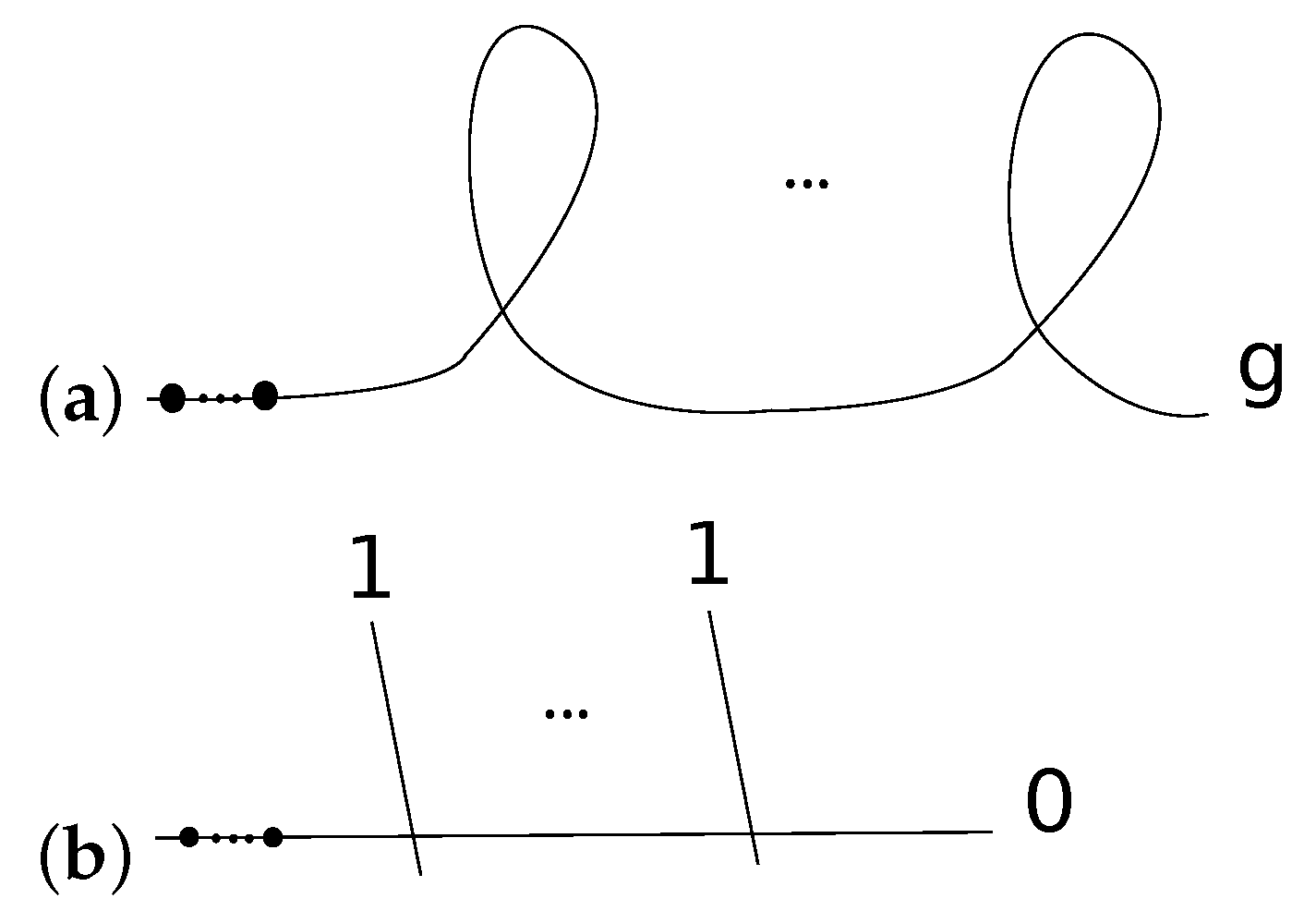Fibonacci, Golden Ratio, and Vector Bundles
Abstract
:1. Introduction
2. Conformal Blocks Vector Bundles
2.1. Notation
2.2. Factorization, Fusion Rules, Propagation of Vacua
2.3. The Verlinde Formula
2.4. Specializing to an Exceptional Lie Algebra
3. Fibonacci Formulas from Factorization
Funding
Institutional Review Board Statement
Informed Consent Statement
Data Availability Statement
Acknowledgments
Conflicts of Interest
References
- Knizhnik, V.; Zamolodchikov, A. Current algebra and Wess-Zumino model in two dimensions. Nucl. Phys. B 1984, 247, 83–103. [Google Scholar] [CrossRef]
- Verlinde, E. Fusion rules and modular transformations in 2d-conformal field theory. Nucl. Phys. B 1988, 300, 360–376. [Google Scholar] [CrossRef]
- Tsuchiya, A.; Ueno, K.; Yamada, Y. Conformal field theory on universal family of stable curves with gauge symmetries. Adv. Stud. Pure Math. 1989, 19, 459–566. [Google Scholar]
- Ueno, K. Introduction to conformal field theory with gauge symmetries. Geom. Phys. Lect. Notes Pure Appl. Math. 1997, 184, 603–745. [Google Scholar]
- Looijenga, E. From WZW models to modular functors. In Handbook of Moduli; Int. Press: Somerville, MA, USA, 2013; Volume II, pp. 427–466. Available online: https://arxiv.org/abs/1009.2245 (accessed on 20 February 2021).
- Narasimhan, M.; Ramadas, T. Factorisation of generalized Theta functions I. Invent. Math. 1993, 114, 565–623. [Google Scholar] [CrossRef]
- Beauville, A.; Y. Laszlo. Conformal blocks and generalized Theta functions. Commun. Math. Phys. 1994, 164, 385–419. [Google Scholar] [CrossRef] [Green Version]
- Faltings, G. A proof of the Verlinde formula. J. Alg. Geom. 1994, 3, 347–374. [Google Scholar]
- Pauly, C. Espaces de modules de fibrés paraboliques et blocs conformes. Duke Math. J. 1996, 84, 217–235. [Google Scholar] [CrossRef]
- Fakhruddin, N. Chern classes of conformal blocks. Compact Moduli Spaces Vector Bundles 2012, 564, 145–176. Available online: https://arxiv.org/abs/0904.2918 (accessed on 20 February 2021).
- Marian, A.; Oprea, D.; Pandharipande, R. The Chern classes of the Verlinde bundles. Proceedings of String-Math Bonn 2012. In Proceedings of Symposia in Pure Mathematics; American Mathematical Soc.: Providence, RI, USA, 2015; pp. 87–111. Available online: https://arxiv.org/abs/1308.4425 (accessed on 20 February 2021).
- Mukhopadhyay, S. Strange duality of Verlinde spaces for G2 and F4. Math. Z. 2016, 283, 387–399. [Google Scholar] [CrossRef]
- OEIS Foundation Inc. The On-Line Encyclopedia of Integer Sequences. 2019. Available online: http://oeis.org/A020876 (accessed on 20 February 2021).
- McSorley, J. Counting structures in the Möbius ladder. Discret. Math. 1998, 184, 137–164. [Google Scholar] [CrossRef] [Green Version]
- Sorger, C. La formule de Verlinde. Astérisque 1996, 237, 87–114. [Google Scholar]
- Gregoire, C. The Space of Generalized G2-Theta Functions. Available online: https://arxiv.org/abs/1103.3514 (accessed on 20 February 2021).
- Gregoire, C.; Pauly, C. The space of generalized G2-Theta functions of level one. Mich. Math. J. 2013, 62, 857–867. [Google Scholar] [CrossRef]

Publisher’s Note: MDPI stays neutral with regard to jurisdictional claims in published maps and institutional affiliations. |
© 2021 by the author. Licensee MDPI, Basel, Switzerland. This article is an open access article distributed under the terms and conditions of the Creative Commons Attribution (CC BY) license (http://creativecommons.org/licenses/by/4.0/).
Share and Cite
Giansiracusa, N. Fibonacci, Golden Ratio, and Vector Bundles. Mathematics 2021, 9, 426. https://doi.org/10.3390/math9040426
Giansiracusa N. Fibonacci, Golden Ratio, and Vector Bundles. Mathematics. 2021; 9(4):426. https://doi.org/10.3390/math9040426
Chicago/Turabian StyleGiansiracusa, Noah. 2021. "Fibonacci, Golden Ratio, and Vector Bundles" Mathematics 9, no. 4: 426. https://doi.org/10.3390/math9040426
APA StyleGiansiracusa, N. (2021). Fibonacci, Golden Ratio, and Vector Bundles. Mathematics, 9(4), 426. https://doi.org/10.3390/math9040426




